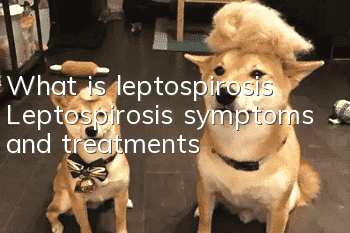What is leptospirosis? Leptospirosis symptoms and treatments

Leptospirosis is a natural zoonotic infectious disease, and dogs are one of the animals affected by Leptospira. In many areas in southern my country, the incidence of this disease is very high, but most dogs show subclinical infection or chronic infection without obvious symptoms. When dogs are infected with highly pathogenic pathogenic Leptospira, they are prone to acute and subacute clinical disease. Cats are rare.
【Pathogens and Epidemiology】
1. Pathogen:The pathogen is Leptospira. Among the 25 serogroups isolated so far, Leptospira jaundice hemorrhage group and canine group have the strongest pathogenicity. Mainly through direct contact, it can be transmitted through skin wounds, intact mucous membranes and digestive tract.
2. Source of infection
Mainly sick dogs and poisonous dogs. During bacteremia, certain blood-sucking insects can serve as vectors of transmission. The hosts involve almost all warm-blooded animals in nature, among which mammals such as rodents, carnivores and marsupials as well as domestic animals are the main storage hosts in my country.
Because rodents are widely distributed, reproduce quickly, are subclinically infected with Leptospira, and excrete bacteria in their urine for a long time, they have become the main source of natural epidemics.
3. Susceptible animals
All kinds of dogs are susceptible to this disease, but male dogs have a higher antibody positivity rate, and puppies and dogs with weak constitutions are more susceptible to the disease and have severe symptoms. Affected dogs can shed bacteria continuously or intermittently in their urine, and recovered dogs can shed bacteria intermittently for months to years, thus causing serious pollution to the surrounding environment.
4. Popular characteristics
It is widely found on both sides of rivers, lakes, swamps, paddy fields, ponds and other places in tropical and subtropical areas with warm climate and high rainfall. The suitable pH is 7.0~7.6.
【Symptoms】
The incubation period is 5 to 15 days, and it mainly manifests two types: acute hemorrhagic jaundice and subacute or chronic nephritis.
1. Acute hemorrhagic jaundice: Systemic abnormalities such as elevated body temperature, depression, vomiting, and loss of appetite at the beginning of the disease, visible mucosal congestion or bleeding spots, widespread muscle tenderness, and limb weakness. Subsequently, most of the affected dogs developed generalized jaundice, with turbid urine that was the color of soybean oil or red. Some of the affected dogs developed hematemesis, epistaxis, and bloody stools. They also developed severe liver failure, large amounts of ascites, and symptoms of hepatic encephalopathy. The dog's abdomen was distended and hemorrhagic ascites on puncture.
2. Subacute nephritis: Severe cases also show a series of systemic abnormalities such as increased body temperature, but as the disease progresses, the main manifestations are renal dysfunction, oliguria or anuria, and a few dogs suffer fromExtensive kidney damage results in symptoms of uremia, vomiting, dehydration, bad oral odor, and later coma and death.
【Diagnosis】
Based on the elevated body temperature, jaundice and mucosal bleeding spots in the skin and mucous membranes, thick soybean oil or red urine, decreased red blood cells, increased white blood cells, and low platelets, the serum urea nitrogen and creatinine concentrations of dogs with varying degrees of renal failure increased. A preliminary diagnosis can be made if the liver and kidneys are damaged to varying degrees on autopsy. However, for chronic cases with no obvious clinical symptoms, laboratory tests are required to confirm the diagnosis. The patient's urine (blood can be obtained in the early stage of the disease, and urine can be obtained in the middle and late stages of the disease) can be centrifuged at 1500 rpm for 5 minutes, and the precipitate should be collected at low temperature. The diagnosis can be confirmed by observing under a dark field microscope, if you see Leptospira that looks like a question mark.
【Treatment】
Usually, large doses of penicillin are used first, and tetracyclines, aminoglycosides or fluoroquinolones are used after a few days, which are more effective in clearing Leptospira in the kidneys. Due to the severe liver function damage and hemorrhagic lesions in acute and subacute dogs, nutritional support therapy and necessary cardiotonic, diuretic, hemostatic, hepatoprotective therapies, etc. should be used. Refer to the treatment of canine infectious hepatitis.
【Prevention】
This disease focuses on prevention, which includes three aspects: eliminating various animals that carry bacteria and expelling bacteria; disinfecting and cleaning contaminated drinking water, venues, and utensils to prevent the spread of the disease; and vaccination.
Imported vaccines include Interwin International Co., Ltd.'s bivalent "Canine Leptospira Inactivated Vaccine", which is highly protective and can prevent dogs from excreting pathogens from their urine to pollute the environment. When using it, it is recommended that puppies be vaccinated for the first time at least 8 weeks old, with a second vaccination at an interval of 2 to 4 weeks, and a booster vaccination once a year thereafter.
- Which dog is the most loyal to its owner? Let your Doberman Pinscher be loyal and protective of his owner!
- How to take care of a Rottweiler dog after giving birth
- Tips for daily grooming your dog
- What kind of adverse reactions will dogs experience after being vaccinated? Precautions related to dog vaccination!
- Determine the dog’s health status based on the dog’s physical condition
- How to train a Doberman Pinscher? What should you pay attention to when training?
- What's the Bull Terrier's personality like, and is it easy to raise?
- What should English Foxhounds eat after giving birth?
- Why does a pregnant dog have black discharge from its urethra?
- Health Class|Top 10 signs of cancer in dogs



